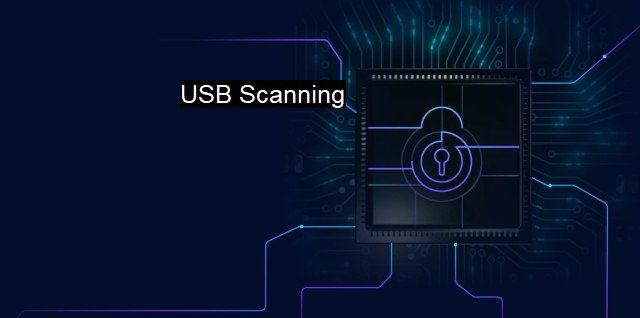What is USB Scanning?
USB Scanning: A Critical Component of Cyber-Security to Detect Malware Attacks
USB scanning refers to the cybersecurity mechanism that detects and mitigates threats from USB devices inserted into computers or networks. Within the context of cybersecurity and antivirus technology, USB scanning plays a pivotal role in safeguarding computer systems against malicious software. The increasing ubiquity of USB devices, coupled with their inherent vulnerability to malware and other threats, makes USB scanning an indispensable component of any comprehensive data security strategy.Typically, USB devices are used for data storage and transfer between different computers and systems. their portability and connectivity make them susceptible to malware, such as viruses, spyware, ransomware, and trojans. These malicious software programs can infect a USB device when it is connected to an infected computer. The malware can then migrate from the USB device to a new computer when the device is used elsewhere, proving USB drives to be an effective transportation method for malware propagation.
USB scanning works by screening the data in a USB device upon its connection to a system. The scanning process involves identifying and neutralizing any malicious programs present in the device before they could potentially harm the host system. Many antivirus programs come with a built-in USB scan function, allowing the software to automatically scan any USB devices the moment they are plugged into a computer.
Modern USB scanning tools and techniques are sophisticated, designed to detect varying types of threats. In addition to identifying known viruses based on their signatures, advanced scanning software can now recognize anomalies and suspicious activity that may indicate the presence of previously unidentified malware or ongoing cyber attacks. These technologies employ a heuristic approach, which involves analyzing the behavior of programs and files to detect potential threats, rather than relying purely on existing malware databases.
USB scanning extends beyond eradication of existing threats. A comprehensive scan also reviews files for potential vulnerabilities that hackers could exploit to deliver malware. For instance, files containing macro scripts - a common feature in word processing documents - can provide an avenue for delivering malicious software, and so, these would typically be scanned more rigorously.
Importantly, USB scanning also contributes to overarching cybersecurity strategies such as incident response and threat intelligence. In terms of incident response, detecting a threat early in a USB device can prevent it from infecting an entire network, effectively containing the incident and mitigating its effect. Concurrently, information gathered during USB scans can feed into threat intelligence systems, providing data that enhances an organization's understanding of emerging threats and associated risk profiles.
To augment USB scanning, users are advised to employ safe practices when using USB devices. This could include regularly updating antivirus software to ensure it recognizes the latest threats, only using USB devices from trusted sources, and refraining from connecting USB devices to computers that lack up-to-date antivirus protection.
In light of an increasingly digitized landscape, where cyber threats are continuously evolving, USB scanning is more crucial than ever. It forms a frontline defense against malware, safeguarding individual devices and entire networks from potential attacks propagated by USB devices. Thus, the effectiveness of USB scanning in thwarting cyber threats underscores its importance in the broader field of cybersecurity and antivirus technology.

USB Scanning FAQs
What is USB scanning?
USB scanning is a process of scanning USB drives or devices for potential security threats such as malware, viruses, or any other malicious software. This process is typically done by an antivirus or cybersecurity software to prevent the spread of harmful files through USB devices.Why is USB scanning important in cybersecurity?
USB scanning is important in cybersecurity because USB devices can be a potential entry point for malware and viruses that can cause significant harm to a computer network. By scanning USB devices, cybersecurity software can detect and remove any potential threats, reducing the risk of data breaches, unauthorized access, and other cybersecurity incidents.How does USB scanning work?
USB scanning works by scanning the files and folders stored on the connected USB device. The scanning process typically involves checking the device for any known malware or viruses by comparing the files to an up-to-date database of known threats. If any suspicious files are detected, the software will alert the user and may either quarantine or delete the file depending on the severity of the threat.Can USB scanning detect all types of malware and viruses?
While USB scanning can detect many types of malware and viruses, it cannot guarantee complete protection against all threats. New types of malware and viruses are constantly being developed and released, and it may take time for antivirus software to update their databases to detect these new threats. Additionally, some malware and viruses may be designed to evade detection by antivirus software. Therefore, it is still important to follow cybersecurity best practices, such as avoiding opening suspicious emails or downloading files from unfamiliar sources, to minimize the risk of infection.| | A | | | B | | | C | | | D | | | E | | | F | | | G | | | H | | | I | | | J | | | K | | | L | | | M | |
| | N | | | O | | | P | | | Q | | | R | | | S | | | T | | | U | | | V | | | W | | | X | | | Y | | | Z | |
| | 1 | | | 2 | | | 3 | | | 4 | | | 7 | | | 8 | | |||||||